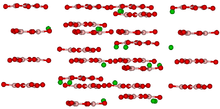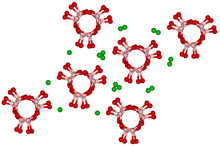Barium borate
| Names | |
|---|---|
| Other names
barium diborate, barium boron oxide, barium metaborate | |
| Identifiers | |
| 13701-59-2 26124-86-7 (monohydrate) 23436-05-7 (dihydrate) | |
| 3D model (Jmol) | Interactive image |
| ChemSpider | 3642855 |
| ECHA InfoCard | 100.033.824 |
| EC Number | 237-222-4 |
| |
| |
| Properties | |
| BaB2O4 or Ba(BO2)2 | |
| Molar mass | 222.95 |
| Appearance | white powder or colorless crystals |
| Odor | odorless |
| Density | 3.85 g/cm3[1] |
| Melting point | 1,095 °C (2,003 °F; 1,368 K)[2] |
| Solubility in hydrochloric acid | soluble |
| Refractive index (nD) |
ne = 1.5534, no = 1.6776 |
| Structure | |
| Rhombohedral, hR126[3] | |
| R3c, No. 161 | |
| a = 1.2529 nm, c = 1.274 nm | |
| Hazards | |
| Safety data sheet | MSDS |
| Flash point | Non-flammable |
| Except where otherwise noted, data are given for materials in their standard state (at 25 °C [77 °F], 100 kPa). | |
| | |
| Infobox references | |
Barium borate is an inorganic compound, a borate of barium with a chemical formula BaB2O4 or Ba(BO2)2. It is available as a hydrate or dehydrated form, as white powder or colorless crystals. The crystals exist in the high-temperature α phase and low-temperature β phase, abbreviated as BBO; both phases are birefringent, and BBO is a common nonlinear optical material.
Properties


Barium borate exists in two major crystalline forms: alpha and beta. The low-temperature beta phase converts into the alpha phase upon heating to 925 °C. β-Barium borate (BBO) differs from the α form by the positions of the barium ions within the crystal. Both phases are birefringent, however the α phase possesses centric symmetry and thus does not have the same nonlinear properties as the β phase.[4]
Alpha barium borate, α-BaB2O4 is an optical material with a very wide optical transmission window from about 190 nm to 3500 nm. It has good mechanical properties and is a suitable material for high-power ultraviolet polarization optics.[5] It can replace calcite, titanium dioxide or lithium niobate in Glan–Taylor prisms, Glan–Thompson prisms, walk-off beam splitters and other optical components. It has low hygroscopicity, and its Mohs hardness is 4.5. Its damage threshold is 1 GW/cm2 at 1064 nm and 500 MW/cm2 at 355 nm.[1]
Beta barium borate, β-BaB2O4, is a nonlinear optical material transparent in the range ~190–3300 nm. It can be used for spontaneous parametric down-conversion. Its Mohs hardness is also 4.5.[1][2]
Barium borate has strong negative uniaxial birefringence and can be phase-matched for type I (ooe) second-harmonic generation from 409.6 to 3500 nm. The temperature sensitivity of the indices of refraction is low, leading to an unusually large (55 °C) temperature phase-matching bandwidth.[2]
Synthesis
Barium borate can be prepared by reaction of an aqueous solution of boric acid with barium hydroxide. The prepared γ-barium borate contains water of crystallization that can not be completely removed by drying at 120 °C. Dehydrated γ-barium borate can be prepared by heating to 300–400 °C. Calcination at about 600–800 °C causes complete conversion to the β form. BBO prepared by this method does not contain trace amounts of BaB2O2[6]
BBO crystals for nonlinear optics can be grown from fluxed melt of barium borate, sodium oxide and sodium chloride.[7]
Thin films of barium borate can be prepared by MOCVD from barium(II) hydro-tri(1-pyrazolyl)borate. Different phases can be obtained depending on deposition temperatures.[8] Thin films of beta-barium borate can be prepared by sol-gel synthesis.[9]
Barium borate monohydrate is prepared from the solution of barium sulfide and sodium tetraborate. It is a white powder. It is used as an additive to e.g. paints as flame retardant, mold inhibitor, and corrosion inhibitor. It is also used as a white pigment.
Barium borate dihydrate is prepared from the solution of sodium metaborate and barium chloride at 90–95 °C. After cooling to room temperature, white powder is precipitated. Barium borate dihydrate loses water at above 140 °C. It is used as a flame retardant for paints, textiles, and paper.[10]
Applications
BBO is a popular nonlinear optical crystal. Quantum linked photons are producible with beta barium borate. Barium borate is a bactericide and fungicide.[11] It is added to paints, coatings, adhesives, plastics, and paper products.
Barium borate is resistant to ultraviolet radiation. It can act as UV stabilizer for polyvinyl chloride.[12]
The solubility of barium borate is a disadvantage when used as a pigment. Silica-coated powders are available. The alkaline properties and the anodic passivation properties of the borate ion enhance the anticorrosion performance. Commonly available barium metaborate pigment comes in three grades; Grade I is a barium metaborate itself, grade II is compounded with 27% zinc oxide, and grade III is compounded with 18% of zinc oxide and 29% calcium sulfate. Barium borate shows synergistic performance with zinc borate.[13]
Barium borate is used as a flux in some barium titanate and lead zirconate EIA Class 2 dielectric ceramic formulations for ceramic capacitors, in amount of about 2%. The barium-boron ratio is critical for flux performance; BaB2O2 content adversely affects the performance of the flux.[6][14]
Barium borate-fly ash glass can be used as radiation shielding. Such glasses are superior in performance to concrete and to other barium borate glasses.[15]
References
- 1 2 3 Barium Borate (a-BBO) Crystal. casix.com
- 1 2 3 BBO Crystals – Beta Barium Borate and Lithium Borate Archived February 12, 2012, at the Wayback Machine.. clevelandcrystals.com
- ↑ Guiqin, Dai; Wei, Lin; An, Zheng; Qingzhen, Huang; Jingkui, Liang (1990). "Thermal Expansion of the Low-Temperature Form of BaB2O4". Journal of the American Ceramic Society. 73 (8): 2526–2527. doi:10.1111/j.1151-2916.1990.tb07626.x.
- ↑ Nikogosyan, D. N. (1991). "Beta barium borate (BBO)". Applied Physics A. 52 (6): 359–368. Bibcode:1991ApPhA..52..359N. doi:10.1007/BF00323647.
- ↑ Alpha Barium Borate. Roditi.com. Retrieved on 2012-01-15.
- 1 2 Ross, Sidney D. "Barium borate preparation" U.S. Patent 4,897,249 issued January 30, 1990
- ↑ Gualtieri, Devlin M.; Chai, Bruce H. T. "High temperature solution growth of barium borate (BaB2O4)" U.S. Patent 4,931,133 issued June 5, 1990
- ↑ Malandrino, G.; Lo Nigro, R.; Fragalà, I. L. (2007). "An MOCVD Route to Barium Borate Thin Films from a Barium Hydro-tri(1-pyrazolyl)borate Single-Source Precursor". Chemical Vapor Deposition. 13 (11): 651. doi:10.1002/cvde.200706611.
- ↑ C. Lu; S. S. Dimov & R. H. Lipson (2007). "Poly(vinyl pyrrolidone)-Assisted Sol−Gel Deposition of Quality β-Barium Borate Thin Films for Photonics Applications". Chem. Mater. 19 (20): 5018. doi:10.1021/cm071037m.
- ↑ Dale L. Perry; Sidney L. Phillips (1995). Handbook of inorganic compounds. CRC Press. p. 3. ISBN 0-8493-8671-3.
- ↑ Henry Warson; C. A. Finch (2001). Applications of Synthetic Resin Latices: Latices in surface castings : emulsion paints. John Wiley and Sons. pp. 885–. ISBN 978-0-471-95461-3. Retrieved 15 January 2012.
- ↑ Koskiniemi, Mark S "Calcium pyroborate as a microbicide for plastics" U.S. Patent 5,482,989 issued 01/09/1996
- ↑ J. V. Koleske (1995). Paint and coating testing manual: fourteenth edition of the Gardner-Sward handbook. 17. ASTM International. ISBN 0-8031-2060-5.
- ↑ K. Singh; Indurkar, Aruna (1988). "Dielectrics of lead zirconate bonded with barium borate glass" (PDF). Bull. Mater. Sci. 11: 55. doi:10.1007/BF02744501.
- ↑ Singh, Sukhpal; Kumar, Ashok; Singh, Devinder; Thind, Kulwant Singh; Mudahar, Gurmel S. (2008). "Barium-borate-flyash glasses : As radiation shielding materials". Nuclear instruments & methods in physics research. Section B. 266: 140. Bibcode:2008NIMPB.266..140S. doi:10.1016/j.nimb.2007.10.018.